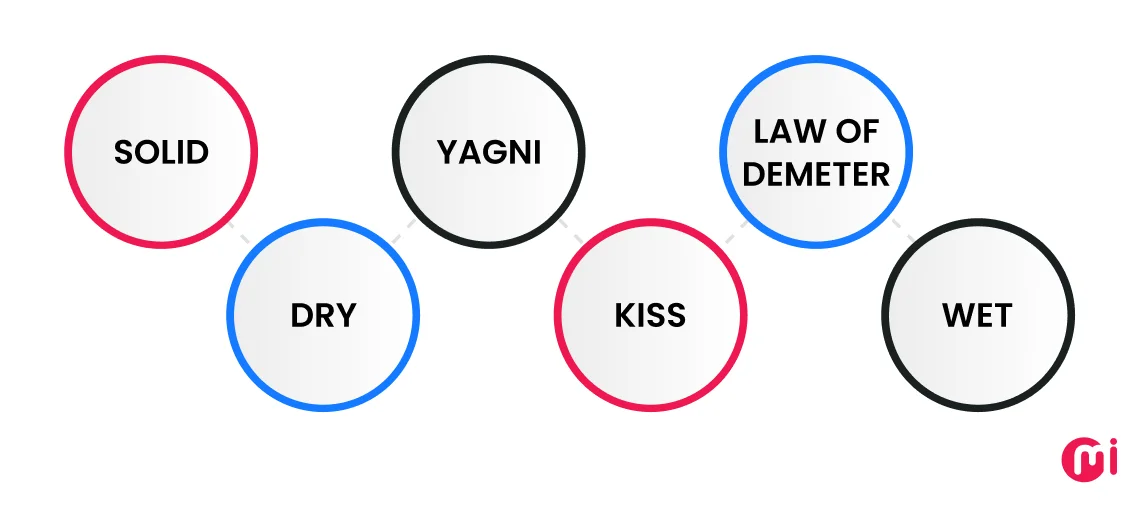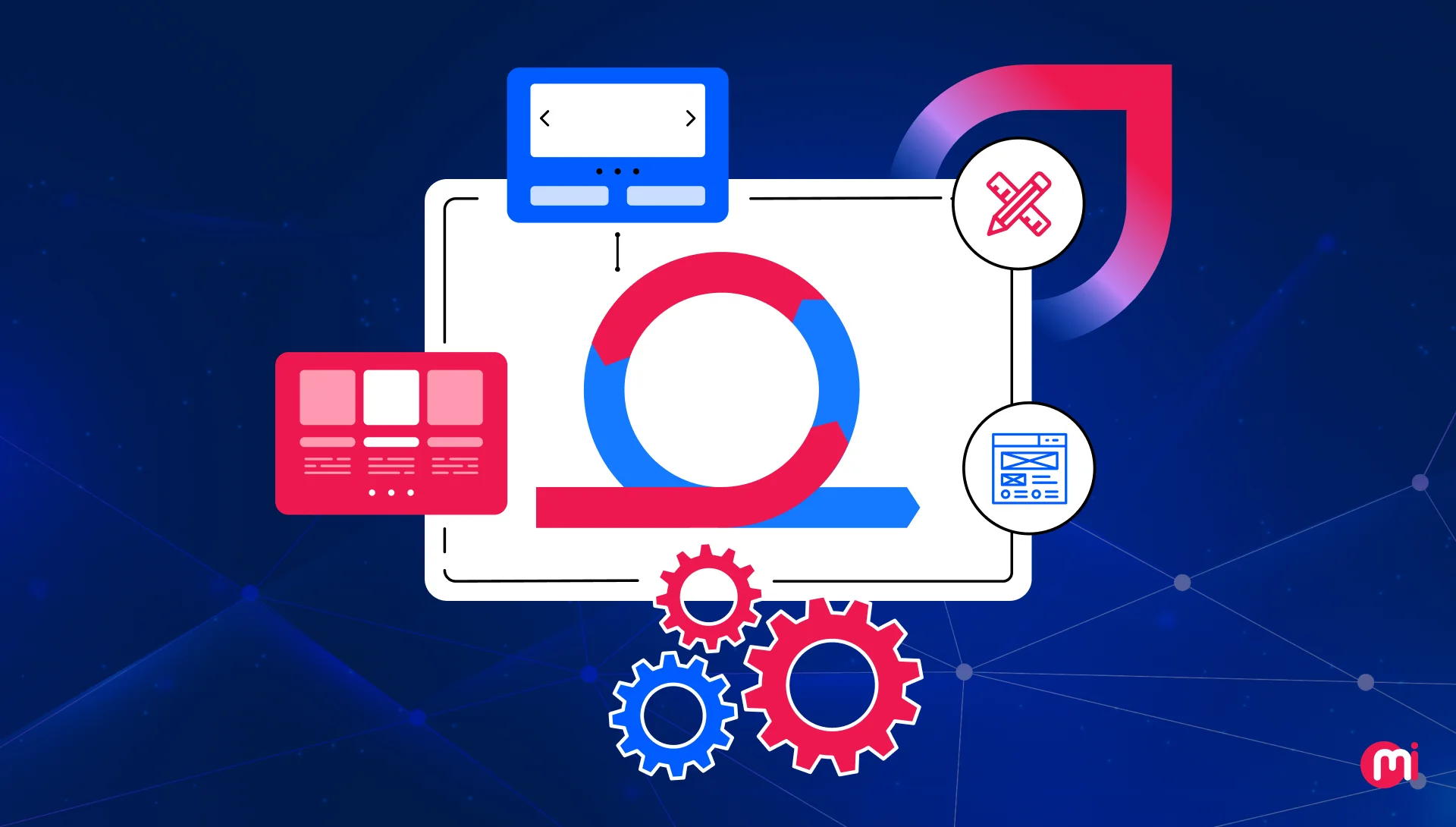What Are Software Design Principles? A Complete Guide
- UI/UX
- August 21, 2025
Software design principles are the backbone of clean, scalable, and maintainable software systems. But what exactly are these principles? Why do they matter in real-world development? And how can they help you write better, future-ready code? This blog on top design principles in software engineering breaks it all down clearly.
Did You Know?
- 43% of enterprise developers spend 10–25% of their time fixing bugs
- 27% struggle with understanding system interdependencies
- 62% say most critical issues are only caught in production
- 18% admit that missed errors in development lead to expensive rework later
You’d think with all the tools and frameworks out there, things would be smoother. But a great realization is that these errors aren’t created due to poor coding skills but rather due to not leveraging core software design principles.
Whether you’re fixing broken features or cleaning messy legacy code, skipping fundamental software design principles like SOLID, DRY, YAGNI, KISS, and more can lead to hidden debt, which piles up fast.
This blog will walk you through the most important design principles in software engineering that every developer, architect, or tech decision-maker should know.
By the end of this blog, you’ll learn what they are, how they help, which one to pick, and when, so you can build software with proper planning that not only scales but also takes less time fixing what should’ve worked in the first place.
| Confused between design principles, architecture patterns, and SDLC models? They often overlap in conversation but serve very different purposes. Read our blogs on software architecture patterns and software development models for a better understanding. |
What are Software Design Principles?
Software design principles are time-tested software development best practices that help you write clean, maintainable, and scalable code.
Software design principles aim to help you structure code logically while reducing code complexity and avoiding duplication, tight coupling, and fragile architecture.
Moreover, design principles in software engineering help teams move faster without sacrificing quality and while ensuring long-term sustainability.
Why are Software Design Principles Important?
Design principles in software engineering provide a roadmap for writing code that’s maintainable, scalable, reusable, and reliable, leading to higher quality and more efficient software systems.
Below are the other reasons why these software design principles make more sense:
- Enables easier code modifications and software updates as requirements evolve.
- Make the software codebase easy to understand and maintain.
- Promotes reusability with modular architecture
- Supports better testing by asking developers to write cleaner, decoupled code
- Scales systems easily by encouraging developers to write simple and untangled code.
- Reduces technical debt by stopping developers from taking shortcuts in software development
- Increases system reliability through a cleaner, modular, and easy-to-understand and test codebase.
- Save time in the long run by asking developers to write software code in a well-organized manner with proper role and responsibility allocation.
- Encourages thoughtful design by shifting developer mindsets from writing code for quick fixes to writing manageable code.
Also Read: Software Design Patterns.
6 Essential Software Design Principles That You Must Know
Essential software design principles include SOLID, DRY, KISS, YAGNI, the Law of Demeter, and WET. So, let’s know about these in detail to better understand what they are, why they are needed, and how they help in modern software development:

1. SOLID
SOLID is an acronym for a collection of five design principles that help to make a software codebase more understandable, flexible, and maintainable. Though at its core, SOLID helps in object-oriented design, it also applies to other modern software architectures, too.
So, let’s understand what this SOLID stands for:
- S – Single Responsibility Principle (SRP)
- O – Open/Closed Principle (OCP)
- L – Liskov Substitution Principle (LSP)
- I – Interface Segregation Principle (ISP)
- D – Dependency Inversion Principle (DIP)
Let’s briefly learn about all SOLID software design principles:
Single Responsibility Principle (SRP):
This principle says that a class should have one and only one reason to change. In simple terms, SRP insists on focusing on one thing and doing it well.
There’s a need for SRP because when a class has multiple responsibilities, even if you make a slight change in one area, it can affect the other. There’s one thing you should know: one responsibility can have multiple small things to do, but having multiple responsibilities doing tons of different things can cause chaos.
When you assign one responsibility to one class, leveraging the SRP, it makes testing, debugging, and modifying easier.
The Single Responsibility Principle works well when you’re:
- Refactoring the code
- Designing new classes
- Seeing long classes with mixed logic
- Using microservices architecture
Open/Closed Principle (OCP):
This principle ensures that software entities (be they classes, modules, or functions) should be open for extension but closed for modification.
This matters because there’s no need to change the existing code to add new features, while you can manage it via inheritance, interfaces, or configuration. But you need to be careful not to end up over-engineering entities to “future-proof” everything. The wise use of OCP when the need for extension is real and much needed.
This open/closed principle can work best when:
- Adding new behaviors or use cases
- Scaling modular systems
Liskov Substitution Principle (LSP)
This principle ensures that you should be able to replace a parent class with one of its child classes without breaking the program.
This LSP matters because when you use inheritance, you’re saying, “this child class is a type of the parent class.” If the child, as a part of inheritance, doesn’t act as a parent, it can lead to bugs, unexpected behavior, and broken code. In the case of reusing a class later on, it can also lead to this. However, not all child classes have to behave exactly like the parent. You may have to test edge behavior for a better understanding.
Using LSP, you can:
- Write more reliable and predictable code
- Avoid surprises when swapping one class for another
- Build cleaner APIs and class hierarchies
- Make your code easier to test and maintain
Using LSP makes more sense when:
- Creating polymorphism and inheritance design
- Creating shared APIs or contracts
Interface Segregation Principle (ISP)
This principle ensures that the user should not be forced to use interfaces they’re not familiar with or don’t use.
It matters because if you design a large, monolithic interface, it can create unnecessary dependencies, leading to complex code that is harder to maintain.
ISP helps to:
- Reduce unnecessary code dependencies
- Make the code easier to change
- Improve code clarity and readability
- Support flexible, modular design
Leveraging the interface segregation principle is even more important when:
- Designing APIs or SDKs
- Supporting multiple client types
Dependency Inversion Principle (DIP)
DIP ensures that both high-level and low-level modules depend on abstractions rather than higher-level ones on lower ones. This principle supports loosely coupled architecture because of the involvement of abstractions.
For example, a high-level module with logging capability should not use a low-level logging library but use its abstracted logging service. This makes it possible to switch the logging library in the future easily without much modification.
Using the dependency inversion principle makes more sense when:
- Integrating external libraries or services
- Using it for clean, testable code and DI (dependency injection)
2. DRY
DRY is an acronym for “Don’t Repeat Yourself.” This principle aims to reduce the repetition of code, logic, or information across the codebase. It is important to have a single, unambiguous, and authoritative representation of every piece of knowledge.
Why? Because when entities are repetitive, they can increase the risk of inconsistencies and maintenance costs. When the same logic is applied to more than one function, if you make a change in the logic for one function, the other becomes prone to bugs, tech debt, and future failure.
It’s best to apply the DRY principle:
- While writing utility functions or business logic
- During code reviews (flag logic duplication)
- When implementing form validations, data processing, or conditional flows
- When building shared libraries or APIs
- When we need to write clean code and a modular design
- In monolithic apps, for maintainability
- In microservices, to reduce logic duplication across services, specifically in distributed systems
While DRY offers benefits like easy maintenance and fewer bugs, overuse of it can introduce premature abstractions, making the code complex to read and maintain.
The rule of thumb for using the DRY principle is to use abstraction only when the code is repeated three times.
3. YAGNI
YAGNI stands for “You Aren’t Gonna Need It.” This principle aims to remind developers not to implement functionality in software until it is needed. Originating from Extreme Programming (XP), YAGNI helps to avoid unnecessary complexity and the utilization of resources in developing premature features.
The stepping up of YAGNI principles makes sense because when you develop features by thinking “just in case,” it leads to:
- Wasted development time
- Bloated codebases
- Higher maintenance costs
- More bugs in unused or unvalidated code
Knowing this, you can say YAGNI encourages minimalism and focus, helping to keep development lean and ensure faster delivery with clean design.
However, it doesn’t mean YAGNI doesn’t support “never plan”; it only asks for “don’t build ahead.” You can think of it as just-in-time design, not no design.
So, you should use the YAGNI principle:
- During feature planning and sprint scoping
- When tempted to “future-proof” code or build “just in case” options
- While refactoring or extending existing systems
4. KISS
KISS is an acronym for “Keep It Simple, Stupid.” It’s a timeless design principle that asks developers to favor simple, straightforward solutions over complex or clever ones. The idea behind this urge is relevant because simple code is easier to read, test, maintain, and debug.
The KISS principle steps in because complex code may look smart today, but may become a nightmare tomorrow, specifically for developers who have not written it. Because this makes it harder to:
- Understand the intent
- Predict edge cases
- Debug issues
- Onboard new developers
KISS aims for clarity over cleverness in software design, and that too at scale.
While it also prioritizes minimalism in coding practices, it doesn’t mean you should “dumb down your code,” but it keeps it as simple as possible, but not simpler.
Hence, you should apply the KISS principle in software development when:
- Writing functions or modules
- Naming variables or structuring classes
- Designing APIs or user flows
- Reviewing or refactoring legacy code
- Any time complexity feels “cool” but not justified
5. Law of Demeter
Well, it is not an acronym for any grouped words, but can be called “LoD” in short and is also known as the “principle of least knowledge.”
This principle suggests that a module/object in software build should only communicate with its immediate “friends,” not strangers. In technical terms, it suggests not to make chain method calls to reach deep into other objects.
A class in a code should only be allowed to call its own methods, where methods can be on:
- Objects it directly holds
- Parameters passed in
- Objects it creates
The use of the LoD principle makes more sense because when methods or objects are too deeply nested within each other, they create dependency and eventually make a tightly coupled system. You know, tightly coupled systems create brittle code, hidden dependencies, and hard-to-maintain systems.
Hence, the Law of Demeter promotes:
- Low coupling
- Higher encapsulation
- More maintainable and testable code
But this doesn’t mean you should write fewer lines; it’s more about ensuring fewer dependencies.
Hence, you should use the Law of Demeter when:
- Designing APIs, classes, or service interfaces
- Doing code reviews of long method chains
- Refactoring highly coupled systems
- Implementing domain-driven design or clean architecture
6. WET
Here, WET stands for “Write Everything Twice.” Contrary to the DRY principle, WET insists that developers write code that’s repetitive, verbose, or duplicated.
You may be feeling like WET seems like a bad practice. But it can be good for early-stage projects or where simple codebases are required.
Many developers prefer to use this WET coding practice for:
- Developing MVPs and prototypes where speed trumps structure
- Writing code that’s deliberately isolated to reduce coupling
- Building an application where abstracting can add more complexity than value
- Clarity and readability in simple, independent functions

Other Important Design Principles in Software Engineering
While DRY, KISS, YAGNI, and SOLID software design principles get most of the spotlight, you should not keep your knowledge limited to them. Modern software development requires clarity, maintainability, and adaptability for future-proofness. This requires the right mixture of foundational and complementary design concepts and principles in software engineering.
Below, we have mentioned those complementary software design principles that may help you write cleaner, smarter, and more scalable codebases. Let’s know them:
Composition over Inheritance (CoI)
This principle encourages developers to build software by merging smaller, independent behaviors over class hierarchies. Many developers find CoI as a better alternative to inheritance that creates tight coupling and deep, fragile class trees.
Its composition method lets you plug and play different capabilities, like giving an object the ability to log, notify, or render, and that too in a loosely coupled manner. This nature leads to greater flexibility, better reuse, and code that’s easier to evolve over time.
Modularity
As the name suggests, this principle asks developers to divide software code into smaller, manageable, responsibility-focused parts known as “modules.”
The use of the modularity principle helps to make it easy to understand, maintain, and test software. The best benefit of a modular structure is that if you make changes in one area (module), it doesn’t affect the other one. Moreover, it enables parallel development while enrolling multiple teams, which not only promotes the reuse of modules but also speeds up the development time.
Abstraction
In software development, the use of Abstraction is an important principle because it helps to hide unnecessary details and reveal what’s relevant and important. It enables developers to work on the higher-level code without understanding the low-level working.
Leveraging this abstraction principle in software development reduces the cognitive load of developers, helping them to easily interact with code and standardize interactions across different parts of an application.
Encapsulation
The encapsulation principle in software development asks developers to implement critical objects in a way that their internal state remains hidden from the modules and objects implemented outside of their environment. In this, the internal state of the object is only allowed to be changed through defined interfaces.
This principle not only helps to keep the data safe and protected from unintended interference but also ensures consistency and allows you to experiment with internal logic without affecting the whole code. In short, you can say encapsulation enforces boundaries that help to keep code safe, predictable, and easier to debug.
Separation of Concerns (SoC)
This principle asks developers to keep their code organized so that each code part can play its role distinctly. It’s like having a different codebase for the application front-end, back-end, and database layers. This separation of application code makes it modular, scalable, and testable.
Separation of concerns makes sense because each code written using it is clearly defined with responsibilities that do not overlap. These codebases reduce the risk of bugs when you make changes to them.
Principle of Least Astonishment (PoLA)
This principle ensures that the software coding should be done in a way that its users and developers expect. For example, if your software has a feature named “send a message,” it should not lead them to something unexpected, like “call” functionality.
The Principle of Least Astonishment promotes a predictable behavior that reduces confusion, improves readability, and lowers the learning curve for new team members. In simple terms, this POLA principle asks developers to code for “does what it says,” which is more about creating intuitive interfaces. This makes it easier to work with, debug, and extend.

Common Pitfalls in Software Design & How to Avoid Them
When software is under development, knowingly or unknowingly, many software developers end up making mistakes that sabotage the scalability, maintainability, and performance of the build. Some of the popular ones include overengineering, tight coupling, ignoring reusability, and insufficient abstraction.
Let’s know some of the common software development challenges/pitfalls developers can make with appropriate solutions:
Over-Engineering
When developing software, many developers end up over-engineering a product by thinking of “just in case.” This happens for many reasons. Some end up with it because they want to “future-proof” the build from the start, some because they overthink edge cases, and some because they misinterpret stakeholders’ needs.
This over-engineering not only slows down software delivery but also confuses teammates and creates maintenance nightmares.
Solution: Follow the YAGNI or KISS software principle
Tight Coupling
When writing quick fixes without architectural thinking, copy-pasting code across components, or not using interfaces or APIs, developers often end up creating modules, classes, or functions that are overly dependent on each other.
This dependency creates tight coupling, which can break the code or slow down progress if you make many changes in one of those pieces of code.
Solution: Use the Dependency Inversion Principle (DIP) or the Law of Demeter to promote loose coupling.
Ignoring Reusability
Reusability of software modules is often misunderstood as duplication. Under pressure to deliver fast, when there is a lack of shared libraries or guidelines, or refactoring code early on, many developers end up duplicating logic. This code duplicity makes work more complex, messy, and inconsistent as it grows.
Solution: Use the DRY software design principle
Insufficient Abstraction
This means mixing responsibilities in one module or exposing too many internal details. When developers are inexperienced with layered architecture, rush through code without design forethought, or believe abstraction adds “unnecessary” complexity, they end up with this mistake.
This mistake leads them to rigid, tightly coupled code that’s hard to test or scale.
Solution: Use Separation of Concerns
Wrapping Up
Whether you’re building a simple app or architecting an enterprise-grade platform, software design principles are what keep your codebase clean, scalable, and resilient. They help you write less code, avoid costly rework, and collaborate better with your team.
You need the right expertise to pick the right one and use the expertise, which MindInventory fills.
Build Better Software with MindInventory
At MindInventory, as the best software development company, we engineer scalable, future-ready software solutions leveraging design principles expertly. They do that by understanding the requirements and knowing the clients’ goals.
Whether you’re modernizing legacy systems, building cloud-native apps, or starting any software product development from scratch, following the best practices, we deliver you the solution with fewer bugs, better performance, and software that evolves with your business.

FAQs About Software Design Principles
The main design principles in software engineering include DRY (Don’t Repeat Yourself), KISS (Keep It Simple, Stupid), YAGNI (You Aren’t Gonna Need It), SOLID software design principles, and many others.
If you use software design principles correctly, there are long-term benefits, but if not, it can lead to over-engineering, an increased learning curve, and slower early-stage development.
Software design principles are high-level guidelines or philosophies for writing better code (e.g., DRY, KISS, SOLID).
Design patterns are reusable solutions to common software design problems, like Singleton, Factory, or Observer patterns.
In short, principles guide how you think, while patterns guide how you structure your solutions.
SOLID software design principles improve software architecture by enhancing modularity, improving flexibility, supporting scalability, and reducing bugs and rework.
The KISS principle encourages developers to write straightforward, readable code without unnecessary complexity, while YAGNI reminds developers to avoid building features until there’s a real need. These software design principles help to keep your software lean, focused, and easier to manage.













